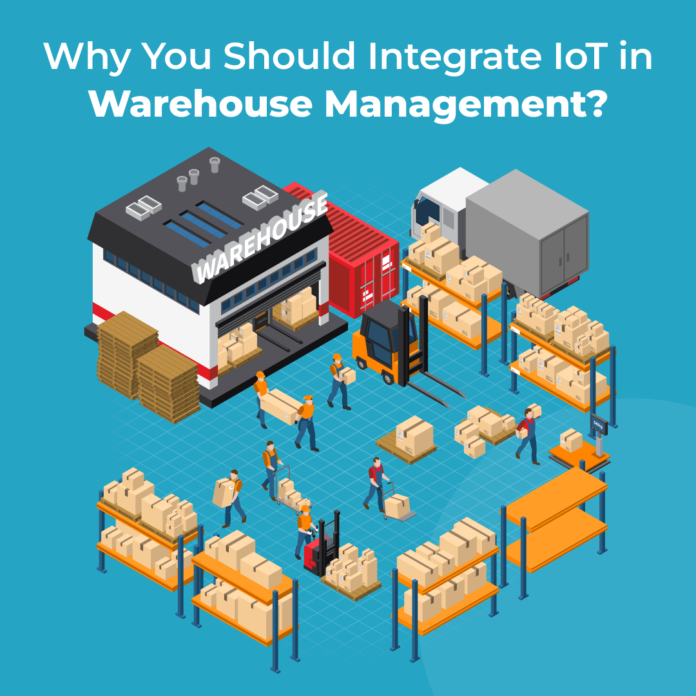Everything that you order online gets delivered to you from a warehouse. A warehouse is a large building for storing huge amounts of goods. Any errors in inventory management in these warehouses can lead to wrong product deliveries and cause huge financial losses.
If you are in any way related to supply chain management and logistics, then you must read this blog till the end.
IoT is so versatile that it can be integrated into any process to yield extra benefits.
Let’s find out why you should integrate IoT in warehouse management.
What Benefits Does IoT Bring to the Table?
By including IoT technology in warehouse management, shoppers can expect faster deliveries, irrespective of their location, smoother customer journeys, and vast product selections.
It’s not like the Internet of Things is new in the warehouse sector. Business giants like Amazon and Walmart are using Internet of Things technology in warehouse management and thus have a competitive edge in the market.
Here are some benefits that IoT brings to the table:
- Supply chain transparency
Supply chain players are spread all across the country, and the deliveries can be stretched for thousands of miles, so it’s pretty challenging to control every single step of the process.
However, IoT connected platforms will help managers track the goods’ status, their location, and their vehicle speed. All of this- in real-time.
So, in case of any emergency or error, the company will get an alert.
- Prevents damage and wastage
Around one-third of all food items, get spoiled when in transit. As majority of the time, warehouses fail to create an ambient storage atmosphere for the food items.
By installing IoT systems in the warehouse and integrating them into logistics, the team can easily track and adjust the shipment containers’ temperature, pressure, and moisture levels. This way, companies can cut spoilage-related losses.
- Strengthens Inventory Management
IoT will make the management of every single item stored in the warehouse easy. By integrating sensors in the entire warehouse, the team can easily locate the good’s position, get low-stock alerts, and also get notifications if any product is misplaced.
Even in cases of theft, the store managers will be alerted, increasing the chances of product retrieval and determining the person responsible for this.
- Helps Fight Skill Shortage by Automating Task
Finding skilled talent is still a challenge for warehouses, and this results in a labor shortage. However, this skill shortage can be addressed through automation. By automating a few stuffs in the management process, the productivity of the existing team will increase tenfold.
5 IoT Applications in Warehouse Management
I already stated the benefit of using IoT in warehouse management. Now let’s learn how and where you can integrate IoT in the entire warehouse management process.
- Automation
IoT is all about automating stuff and reducing human intervention. A warehouse is one place that needs automation for the team to act productively. IoT devices and systems can do more than just assembling orders. The IoT devices can collect tons of data, such as total stocks and the inventory list, thus allowing employees to focus on other important tasks.
- Assets and Inventory Management
Using IoT in inventory management will help you shine in ground-level warehouse governance. With IoT, the warehouse team will be aware of each moving part. They don’t have to open several files just to get one little information. The connected sensors will track each asset in the warehouse. The smart shelves can display inventory information to alert managers about low stock and expired stock.
- Wearables
Wearable devices in any form can be issued to the employees in the warehouse, and with the help of this, the warehouse managers can monitor and track the performance of each employee remotely. These wearables can also track the location of the employee inside the facility and their health status, thus improving the safety of the premises.
- Transportation
Installing a telematics system and GPS feed in transport vehicles will ensure that the driver follows the correct route and that the team can receive accurate ETA information.
In addition to this, IoT sensors or RFID tags can also be placed on the goods box to track the product’s journey beyond the vehicle and make sure it reaches its destination.
- Maintenance
IoT- based Warehouse management systems can help the team track the operating condition of machines in real-time. The data received about this operational equipment will allow the team to predict the failures of the necessary material lifting and handling equipment.
All these above-mentioned applications of IoT in warehouse management transform the warehouses into “smart warehouses,” making the entire supply chain management more efficient and user-focused.
After all, the business totally depends on how the user reacts to their service. All these granular changes will eventually lead you to serve your customers more effectively, and in turn, you will have an increased customer base.
Now that you have the answer for why you should integrate IoT in warehouse management, let’s just start working on it.
Psiborg is an IoT solutions company that offers IoT solutions across all industries to support each and every business. If you want to implement warehouse automation and inventory management systems, then PsiBorg is one company that you should look out for.
Thank you for reading!

